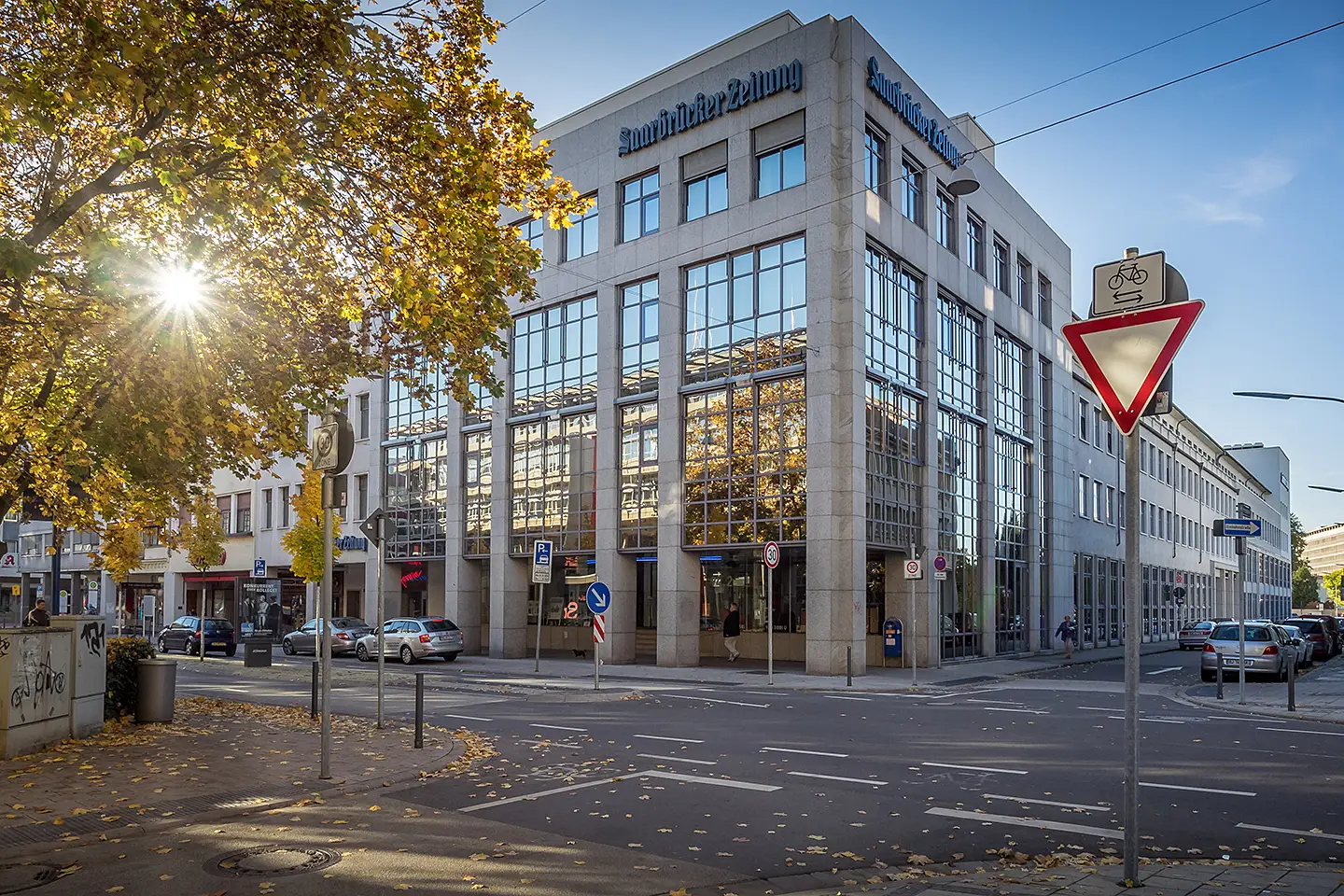The Hofer Family and their Saarbrücker Zeitung
The Hofer Family and their Saarbrücker Zeitung
No publication in Saarbrücken or the Saarland is as well-known as the Saarbrücker Zeitung. The Saarland’s only daily newspaper is not only, in fact, the third-oldest newspaper in Germany; it also feels as though it has always been there, and there is hardly anyone in Saarbrücken and beyond who hasn’t held a copy at least once.

The following notes come from a handwritten family chronicle of the Hofer family [1], which Mrs. Hildegard Hofer, née Kraemer, copied by hand multiple times—complete with family coat of arms—into albums and presented to her children as birthday gifts in the 1990s. She begins the chronicle with a note on her records:

In what follows, I will reproduce the notes of Hildegard Hofer, slightly adapted in places and put into more modern wording. The story is fascinating, even though very few people in Saarbrücken today make a direct connection to the name Hofer. Yet this family played, in my opinion, the greatest role in building what we now know as the Saarbrücker Zeitung, and thus in fostering knowledge as well as political and cultural education in the Saarland. Hardly anyone remembers that well into the early 20th century, the intersection of Eisenbahnstraße and Gutenbergstraße—where the newspaper’s publishing house still stands—was colloquially known as the “Hofersches Eck” [2]. The roughly 200 years between the printing of the first paper and the eventual (partial) expropriation of the family by political forces are worth telling. And so, to the notes of Hildegard Hofer:
The Hofer family descends from an old lineage of printers. Johann Hofer, who at the beginning of the 17th century owned an art print shop in Nuremberg and, according to his son’s notes, was exceptionally proficient in his craft, described himself as an imperial citizen of the free city of Nuremberg. His death forced the widow to give up the business.
One of their sons, Bernhard Gottfried, born on October 24, 1729, devoted himself to his father’s art and wrote: ‘When I was at the Highest’s Gymnasium, I came to the noble art of printing and learned it for five years with Andreas Riesling.’ He then set out, as was customary at the time, to travel and further his training in the world. He meticulously recorded his journeys, from which we see that he was a lively, pious, and enterprising printer. He worked in almost all the cities then famous for the ‘black art’: among others Vienna, Augsburg, Prague, Dresden, Berlin, Leipzig, Frankfurt, Würzburg. From there he planned to go to Switzerland, but on the way he learned that there was a position in Zweibrücken and stayed there for some time.
Soon, however, the restless one moved on again. He worked in Switzerland, in Constance, Strasbourg, Karlsruhe, and then, having returned to Zweibrücken for a few months, intended to visit his native city and settle there.
‘But as the dear God,’ he writes guilelessly, ‘showed me another path, I followed the advice of good friends and acquaintances and went to Saarbrücken, where the dear God had chosen for me to earn my bit of bread in peace. There I became engaged to the only daughter of Mr. Court Printer Mengert.’ The Saarbrücken civil registry notes on November 29, 1759 (the translation is surely not exact): Bernhard Gottfried Hofer, legitimate unmarried son of Johann Hofer, former printer in Nuremberg, now weds Maria Dorothea, of the Reformed religion, daughter of the local court printer Johann Heinrich Mengert.”

With this marriage, in 1761, the printing house of his father-in-law passed into the possession of Bernhard Gottfried Hofer, who, through diligence, soon became Court Printer to the Prince of Nassau-Saarbrücken. Truly a good solution for all involved. Along with his new privilege, he received the house at Talstraße 2 as a residence, as well as free deliveries of wood and coal. [3]

Before us stands the image of a modest, devout citizen whose entire being is rooted in trust in God. In faithful belief, he laid the foundation of the enterprise that would become the later Saarbrücker Zeitung, today the third-oldest newspaper in Germany. It began its development 300 years after the invention of the printing press.
The prince, Wilhelm Heinrich of Nassau-Saarbrücken (1718–1768), who began his reign in 1741, was a significant promoter of trade and industry. Together with his architect and master builder Friedrich Joachim Stengel, he oversaw the redesign of the Saar towns of Saarbrücken and St. Johann. He had Ludwigskirche (completed in 1775) and the Old Catholic Church built. (Enclosed is a copy of the ‘good wishes’ printed by Gottfried Bernhard Hofer for the laying of the foundation stone of the Ludwigskirche.)”

In 1761, to speed up the unloading of Saar ships, the Saar crane was built. The destroyed crane is being rebuilt today to preserve such old things for posterity. The population has increased: 200 houses with 180 households in Saarbrücken.
On January 24, 1761, the progressive Prince Wilhelm Heinrich announced to his subjects ‘that he had long wished to extend to his faithful subjects the advantages and conveniences which others elsewhere enjoyed through gazettes.’
On January 24, 1761, the prince’s chancery, on his behalf, issued a call to the Nassau-Saarland subjects to ‘subscribe to the weekly paper that would appear for the first time at Easter.

Court Printer Bernhard Gottfried Hofer was commissioned to print the ‘General Weekly Paper’. The publisher’s duties and the financial risk were left by Wilhelm Heinrich to the printer Hofer. Hofer tried, even in announcing the paper, to keep this risk small. Those who intended to subscribe in advance were to pay only 20 kreuzer per year (with weekly delivery)! ‘Others,’ it was threatened, ‘who do not keep up with the paper properly, will receive it irregularly and pay 1 kreuzer for each individual issue.’
Might the whole idea have come from the enterprising court printer Hofer, who, in view of the economic upturn along the Saar and the rapidly growing population, sniffed out a profitable business? Be that as it may—from Easter 1761 onward, the paper appeared weekly under the title ‘Nassau-Saarbrückisches Wochenblatt’.
Unfortunately, no copies survive from the first three years; the oldest known issue dates from September 25, 1764. [4]

In 1777, the founder of the newspaper, Bernhard Gottfried Hofer, died. His widow Maria Dorothea Hofer ran the printing house for the next ten years, until their son Christian (1766–1820) could take over the paternal inheritance. Under Prince Ludwig, he guided the paper and steered it through the storms of the revolutionary era. Christian died in 1820.
In the following years, his widow Dorothea-Katarina Hofer, née Schulze, of Saarbrücken, managed the business. In September 1836, she announced a change of title to “Intelligenz-Blatt”, stating that in addition to the necessary, the paper intended to make room for the useful and the pleasant, and would henceforth appear twice weekly. “To meet the wishes of many subscribers to this paper, I intend, with the approval of the High Oberpräsidium of the Rhine Province, to give it a broader scope from October of this year,” etc.

She was also the one who, for a long time, had to submit a copy of her likely non-political paper each week to the Metternich-era censors, personally guaranteeing the content with her signature. Week after week, the mayor’s office certified the non-political content of the “Widow Hofer.”
Censorship was neither the first nor the last of its kind. Widow Hofer ran the business into old age. Anton Traugott, son of Christian and grandson of Gottfried (May 27, 1806 – June 12, 1864), took over the company. It fell to him to initiate the paper’s future upswing from a small local sheet to a respected daily newspaper. On January 1, 1861, he gave the paper the title “Saarbrücker Zeitung.” The printing and publishing operations were moved to Eisenbahnstraße 8, next to the Friedenskirche. Three years later, the company traded as “Gebr. Hofer” (Hofer Brothers), the brothers being Anton’s sons Fritz (1834–1880) and Carl (1838–1887).
During their joint ownership, a new building was erected on Eisenbahnstraße in 1871, and the company moved to this future traditional location [5]. In this period under the Hofer brothers, a very interesting event took place: in 1870, the newspaper published the first balloon-borne airmail reports in contemporary history.
After Fritz Hofer died in 1880, Carl Hofer the Elder managed the publishing house until 1887. Carl died, and his widow Johanna—from the well-known Saarbrücken Jacob family—took over the management together with their son Carl the Younger (1866–1915).
Meanwhile, Johanna’s youngest son Richard finished his training. He was born on April 4, 1887. Following the old family tradition, he devoted himself to his forefathers’ art and became a master printing machinist. He received further professional training in Freiburg, where he also completed commercial studies. In 1910, he returned to Saarbrücken and, after being granted power of attorney, joined the company. In 1912, he became a partner. In 1915, Carl Hofer Jr. died, and Richard became the sole managing director. His wife Liselotte, née Poppen (born August 7, 1890), was from Waldkirch im Breisgau and supported him with all her strength. She died of influenza on October 20, 1918.
A difficult time began for Richard, both professionally and privately. His mother Johanna died on November 14, 1918. In 1920, the French occupation authorities expelled the publishing management and editorial staff. The paper was banned throughout the Saar territory. The editorial team and Richard Hofer had fallen afoul of the authorities and avoided arrest by fleeing to Baden-Baden. (Already in 1828, the newspaper’s reporting had displeased the French government; I wrote about Widow Hofer, the wife of Christian.) Richard remained in Baden-Baden, intending to open a printing house there. He unexpectedly sold his majority shares. According to a letter, he saw the only way to preserve the paper’s German character in selling. [6]

He died suddenly on January 5, 1921, in Baden-Baden. That marked the end of Hofer family ownership. The Gebr. Hofer AG was founded. The sons of Richard and Liselotte were Gerd and Hanskarl. Because of their parents’ early deaths, they were raised by their grandmother Trudel Poppen. They spent their youth in Waldkirch in the Black Forest. With an eye to a possible future role in their father’s former company, both sons learned the printers’ trade and became certified master printers.
The widow of Carl Hofer the Younger still held shares in Gebr. Hofer AG. With skillful negotiation, it might have been possible for the young Hofers to re-enter the company. People hoped so—until the war in 1939. [7]
Things turned out differently. Gerd and Hanskarl returned from the war safe and sound. They tried to obtain a publishing license, which was impossible during the French occupation. After the war, Margarete Hofer, widow of Carl Hofer Jr., sold her remaining shares in Hofer AG. With that, any chance of ever re-entering the company was gone. Without offering the shares to the family, she squandered the last opportunity.
Gerd had since married Hildegard Kraemer (b. July 7, 1917) and joined his in-laws’ business, Juwelier Kraemer in Saarbrücken.
The younger brother, Hanskarl (b. January 2, 1918), also a printer, married Gisela Beck from Bochum. Their son is Richard. Hanskarl worked for various publishers. He led the magazine “Die Elegante Welt” for two years and later worked at a trade magazine in Bad Wörishofen. He died on July 1, 1980.”
Thus end the notes of Hildegard Hofer.

With the end of this story, the Hofer era at the Saarbrücker Zeitung ended — but not the family’s story. As Hildegard wrote, she married Gerd Hofer, and the two ran the business of Juwelier Kraemer, another historically interesting Saarbrücken family. Their eldest (twin) sons, Gerd Jr. and Jürgen, eventually took over the business; Gerd also founded another company in Saarbrücken during those years: the watch brand NIVREL, now based in St. Arnual. The two other children of Gerd Hofer Sr. and Hildegard Hofer live today in Munich (Werner) and near Cologne (Liselotte). The two children of Gerd Hofer Jr. and his wife Gitta run the businesses in Saarbrücken today: son Sven Hofer is owner and managing director of Juwelier Kraemer on Bahnhofstraße in Saarbrücken; daughter Dr. Anja Hofer is, together with her mother Gitta, managing director of NIVREL Uhrenproduktion Gerd Hofer GmbH. Today’s relations with the Saarbrücker Zeitung are friendly and businesslike (as advertisers), but there are no longer any direct ties. At the 250th anniversary ceremony of the Saarbrücker Zeitung at the Staatstheater Saarbrücken on June 9, 2011, the newspaper’s management invited Anja and Sven Hofer and introduced them to the audience during the celebration.
Sources and Notes
[1] The passages reproduced here are taken from the handwritten chronicles prepared by Hildegard Hofer for her eldest sons Gerd (1940–2007) and Werner (b. 1944). I was provided with the original (Gerd Hofer version) and a transcript (Werner Hofer version).
[2] Cf. Gräbner, Dieter; Weszkalnys, Stefan: Bürger, Brücken und Duelle – Die Geschichte der Großstadt Saarbrücken; Conte Verlag, Saarbrücken 2009, p. 39, quoted from the memoirs of Saarbrücken architect Hans Weszkalnys.
[3] Note by Guido Grohmann: The Hofers resided there until 1838; the house had been acquired by Johann Mengert in 1743, cf. Bünte, Hans: Die abenteuerliche Geschichte einer Zeitung – 250 Jahre Saarbrücker Zeitung 1761–2011; Gollenstein Verlag, Merzig 2012, p. 19.
[4] See also Bünte, Hans: Die abenteuerliche Geschichte einer Zeitung – 250 Jahre Saarbrücker Zeitung 1761–2011; Gollenstein Verlag, Merzig 2012, p. 24.
[5] The so-called Hofersches Eck, see [2].
[6] Quotation by Richard Hofer on October 3, 1920, in the Saarbrücker Zeitung under the title “Ein letztes Wort”: “As the readers of the Saarbrücker Zeitung know, I and a large part of my senior staff have been forbidden to stay in the Saar territory and the occupied area. We then tried to manage the paper from outside the borders of the Saar territory, but new measures made even this possibility more and more difficult, to such an extent that I had no other option but to entrust the management of operations to other hands.” Quoted here from: Bünte, Hans: Die abenteuerliche Geschichte einer Zeitung – 250 Jahre Saarbrücker Zeitung 1761–2011; Gollenstein Verlag, Merzig 2012, p. 119.
[7] At this point, Hildegard Hofer’s recollections do not entirely match the historical record. In fact, the branch of the Hofer family that still owned 40% was forced by the Nazis to sell in 1936. See, for example: “Ein aufregendes Kapitel Pressegeschichte,” article in the anniversary supplement of the Saarbrücker Zeitung, May 30, 2011, p. 13.
Comments are closed.


